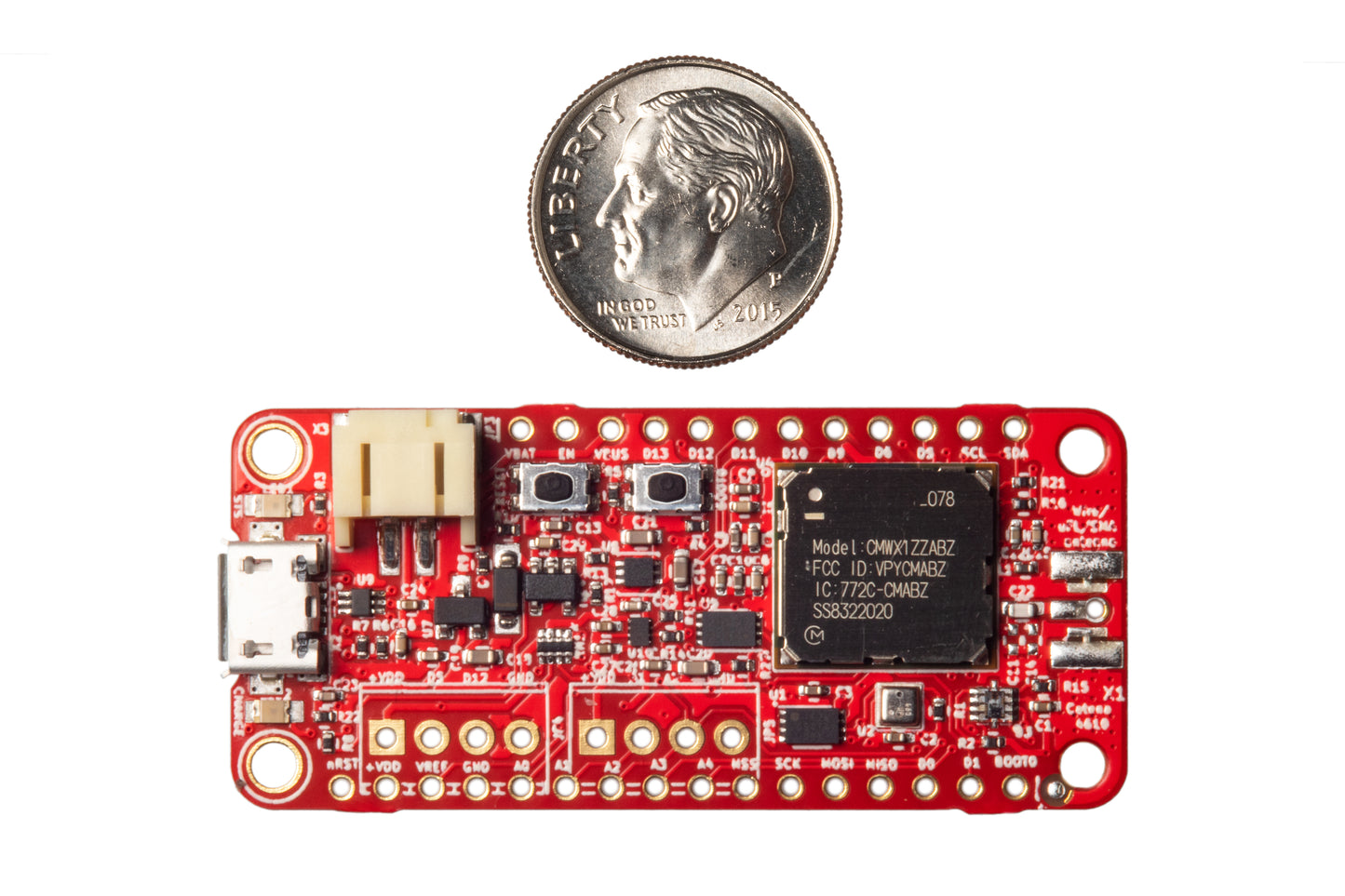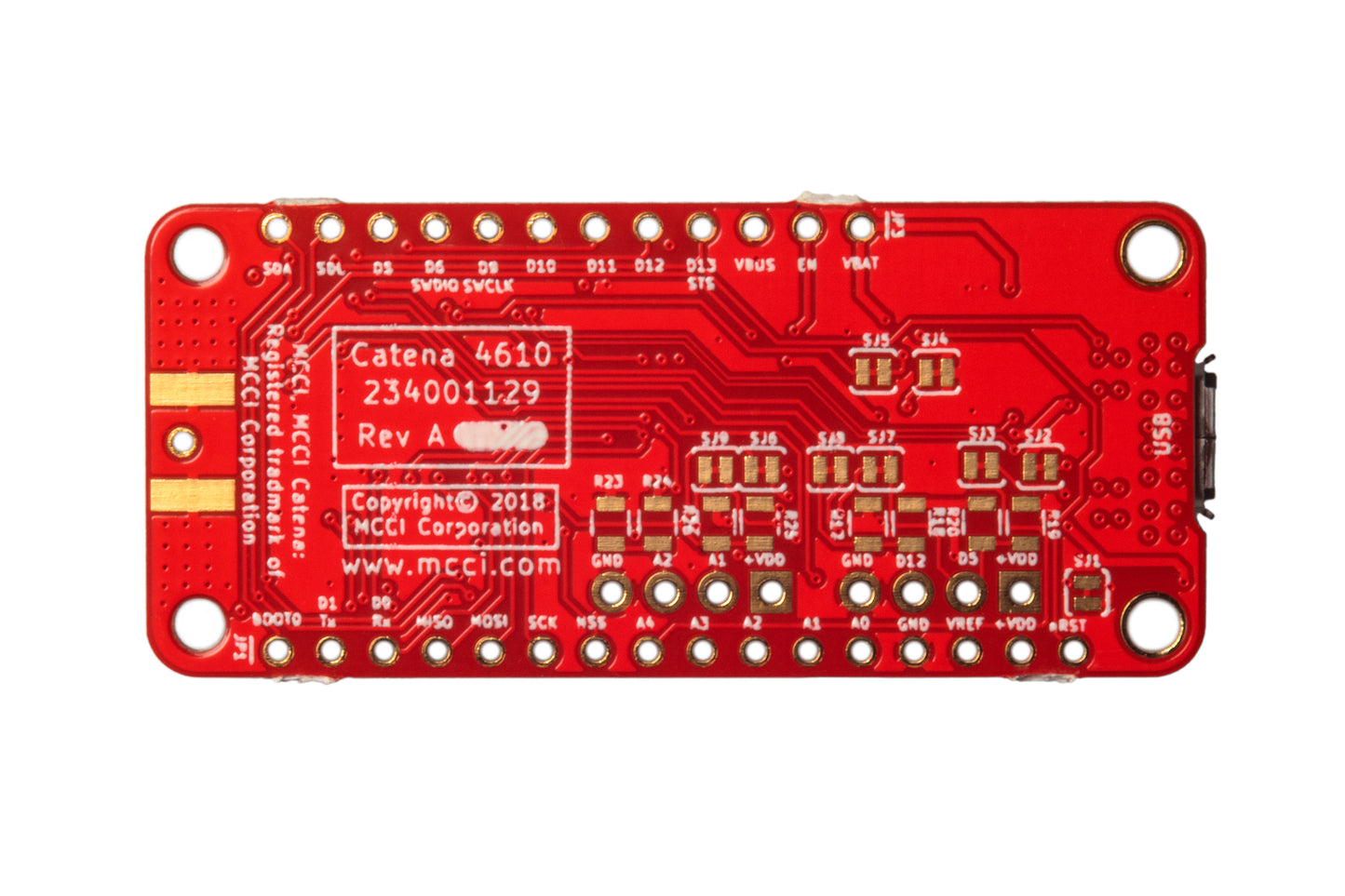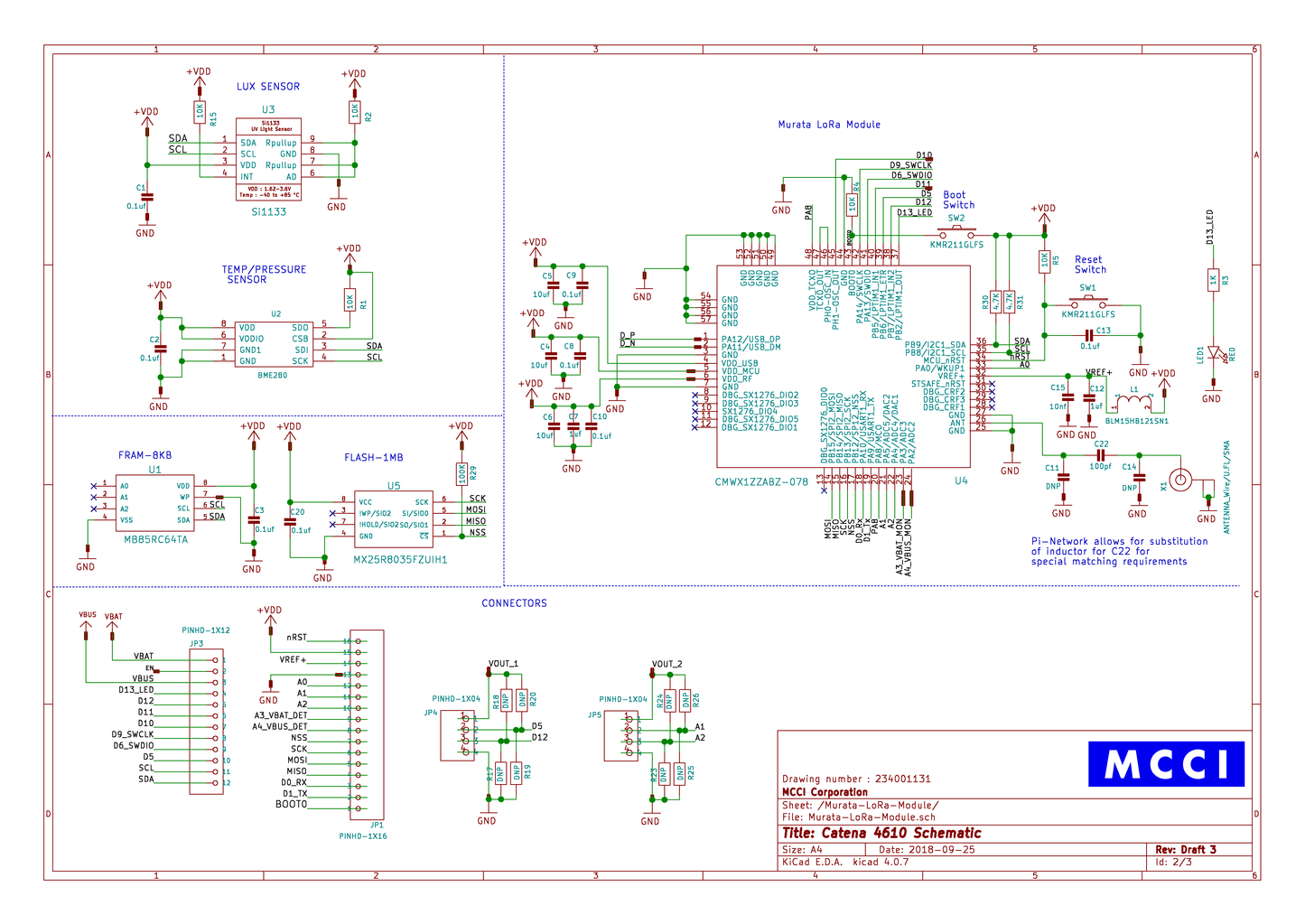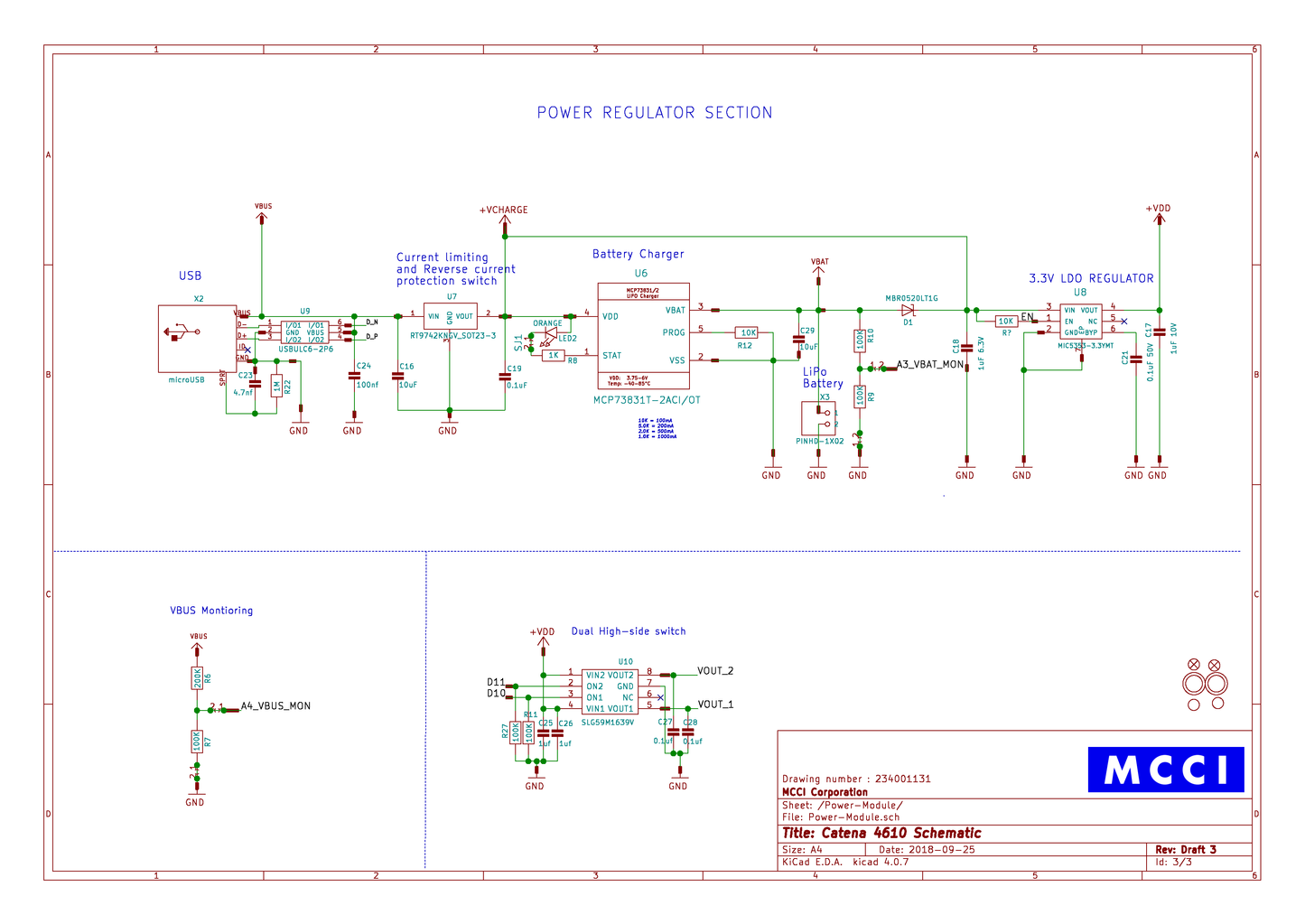MCCI Catena® 4610 Integrated Node for LoRaWAN® technology
MCCI Catena® 4610 Integrated Node for LoRaWAN® technology
SKU:123001515
Out of stock — Available on backorder
Couldn't load pickup availability
The MCCI Catena® 4610 is a complete single-board IoT device for LoRaWAN® technology projects. It combines CPU, radio and integrated sensors.
Based on the Murata CMWX1ZZABZ-078, and designed to be compatible with the Adafruit Feather family of development boards and accessories, the Catena 4610 is a great platform for LoRaWAN investigation and deployment. It works well with The Things Network, or any LoRaWAN 1.0 or 1.1 network in the 865 to 923 MHz range.
Lightweight and small (roughly 2" by 0.9"), the 4610 needs no external components to measure and send temperature, pressure, humidity, and light, powered from USB or any Feather-compatible LiPo (Lithium-Polymer) battery.
Because of the embedded FRAM, the Catena 4610 fully meets the requirements of LoRaWAN 1.1, without worrying about EEPROM wearout or wear-leveling, both for ABP and OTAA.
Specifications and Features
Murata LoRaWAN module
- Semtech SX1276 LoRa radio
- STM32L082 CPU (Cortex M0+, 32 MHz, 192K flash, 20K RAM)
- High quality RF engineering Certified for US and EU
- Compatible with IN866, AS923, AU921 bands
Integrated sensors
- Pressure, temperature, and humidity (Bosch BME280)
- Incident light (Silicon Labs Si1133, measuring IR, white light, and UV)
Additional Features
- Powered from secondary 4V LiPo batteries (such as Adafruit's 350 mAh battery) (Note: in contrast to the Catena 4612, this model targets LiPo batteries only. If you need primary/disposable batteries, please consider the 4612).
- 100uA current draw in stand by
- 8K bytes FRAM for LoRaWAN provisioning info and frame counters -- power can be removed completely without requiring a new join to the network, and without losing uplink and downlink count values (required for LoRaWAN 1.1)
- 1M byte SPI Flash for bulk data storage, future FoTA firmware storage, etc.
- Software-controlled boost converter allows dynamically raising voltage to 3.3V for analog measurement and powering internal sensors
- USB or SWD for download and debug
- Pin-compatible with Adafruit Feather M0 family of boards (some limitations because the of functional differences between the Murata module and the Atmel SAMD21 CPU used in the Feather M0)
- Dedicated boot-mode button easies development with USB firmware download
- Arduino-compatible
- Compatible with the MCCI Catena 4450 and Catena 4612 IoT devices
- Designed for use with The Things Network (open-source, user-owned IoT network based on LoRaWAN); but can be used with any LoRaWAN-compatible network
- Provisions for screw terminals for pulse, analog or digital I/O
- Software-controlled switches for external power output to screw terminals
- Whip, u.FL, or SMA antenna
- Open source hardware and software (https://github.com/mcci-catena)
MCCI provides a full Arduino board-support package, available here.
MCCI also provides libraries to allow rapid prototyping and experimenting, including an open-source LoRaWAN stack that supports the EU868, US915, AS923, AU921 and IN866 regional plans.
ST Micro tools may also be used.
The Catena 4610 works well with and is tested with The Things Network (an open-source, user-owned IoT network based on LoRaWAN); but can be used with any LoRaWAN-compatible network.
Pricing and Availability
The Catena 4610 is available now. MCCI offers several variants.
- The basic board ("BASIC"): ships with 12 and 16-pin terminal strips, unassembled. User attaches antenna (and terminal strips if desired). Whip antennas suitable for 865/868 MHz and 915 MHz MHz operation are supplied. The U.FL connector is pre-mounted.
- The do-it-yourself developer board ("DIY"): same as BASIC (with terminal strips and antennas), adding screw terminals, 350 mAh LiPo battery, stacking hardware, baseplate, and SMT resistors for termination of external inputs. Works with US, Europe, Asia-923, India, and Australian band plans. Factory-assembled version comes with antenna attached and hardware assembled (terminal strips shipped loose).
- The contact monitoring system ("M101"): assembled unit for monitoring up to four contact closures, with screw terminals, 350 mAh LiPo battery, and whip antenna.
- The environmental monitoring system ("M102"): assembled unit for monitoring one or more external Dallas Semiconductor "One Wire" sensors and/or a soil humidity/temperature sensor, with screw terminals, 350 mAh LiPo battery, and whip antenna; for mounting in Stephenson screen (not included). Note that the BME280 sensor is not suitable for use in condensing environments.
For assembled units, variant codes select dedicated antennas for US915/AS923/AU915, EU868, or IN866 operation. Models are available with U.FL connectors for use with external antenna. SMA connectors can be mounted by special order. Contact us for more details.
Volume discounts and custom variants are available. Contact MCCI via email (sales@mcci.com) for assistance.
LoRa and Semtech are registered trademarks of Semtech Corporation. LoRaWAN is a registered trademark of the LoRa Alliance. MCCI and MCCI Catena are registered trademarks of MCCI Corporation. All other trademarks are the property of their respective owners.








